Recent Articles
Popular Makes
Body Types
2016 Chevrolet Camaro Road Test and Review
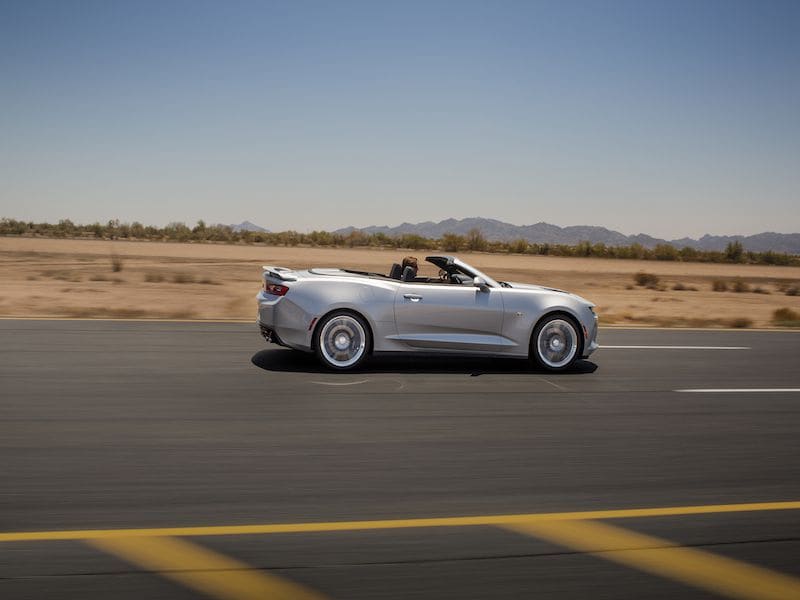
2016 Chevy Camaro convertible - profile
There are two big bits of news regarding the 2016 Chevrolet Camaro. The first is a fresh engine. It’s a 2.0-liter, turbocharged four-cylinder unit, which seems to be the configuration everyone is going for these days in an effort to serve up optimum power while keeping fuel consumption and emissions in check. The Camaro has had a four-cylinder engine before (about 30 years ago), but this is the first time a turbocharger has been bolted on. It provides muscle comparable with small-block V8 engines from the 1990s. The second aspect is that the current generation of this much-loved pony car (the sixth, which debuted for the 2016 model year) is now available as a soft-top convertible with all drivetrains and trim options. Speaking of which, the 2016 Camaro comes in 1LT, 2LT, 1SS and 2SS trim levels. The 1LT and 2LT versions are eligible for an RS package that brings 20-inch wheels, a dedicated grille and rear spoiler, xenon headlights and LED tail lights.
Pricing
Let’s deal with the coupe body style first. The 1LT comes with the 2.0-liter engine linked to a six-speed manual transmission, starting at $26,695. An eight-speed automatic transmission is a $1,495 option throughout the range and can be paired with any engine. The 2LT starts at $30,795. Going for a V6 engine in either of these trim levels is another $1,495. The 6.2 V8-propelled SS level is split into the two sub-sets: 1SS priced from $37,295; 2SS from $42,295. Convertible pricing begins with the 1LT at $33,695. The 2LT starts at $37,795. Then we’re into $44,295 for the 1SS and $49,295 for the 2SS. All these prices include destination charges.
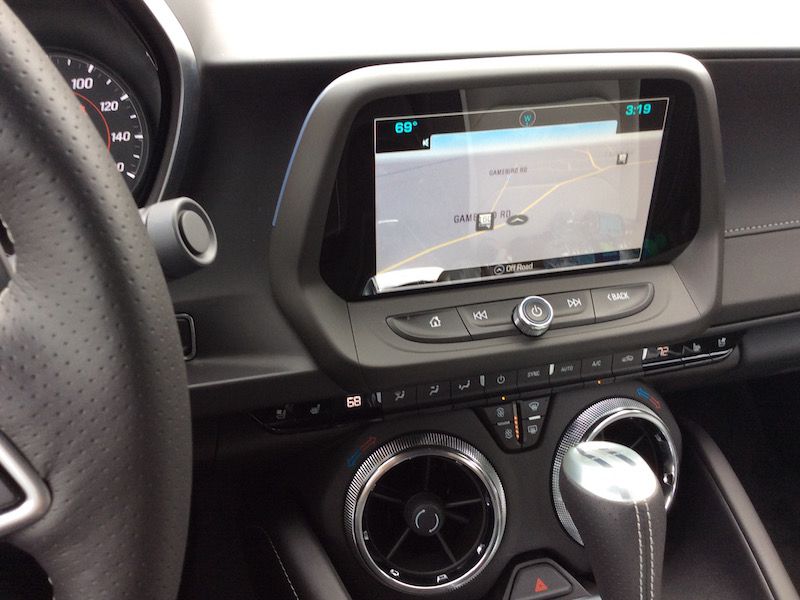
Design
There’s no mistaking this as anything other than a Camaro. Outwardly, it doesn’t look radically different from the previous generation, but only the badge of the SS model and the “bow tie” Chevy emblem at the rear have carried over. On closer inspection, the smaller headlights hint at a more aggressive character. With the fabric roof up, the convertible version still has coupe-like sleek looks. When it’s down, it sinks below a hard tonneau cover to keep the lines clean and simple. In the cabin, if the plastics looked any cheaper, you’d say they looked cheap. As it is, right now they look just about OK, although there are some cheesy surfaces here. Visibility is not great, a common complaint with the Camaro, but we’ll all just have to live with that because this is a sports coupe (or a convertible, whose visibility is obviously way better when the roof is down).
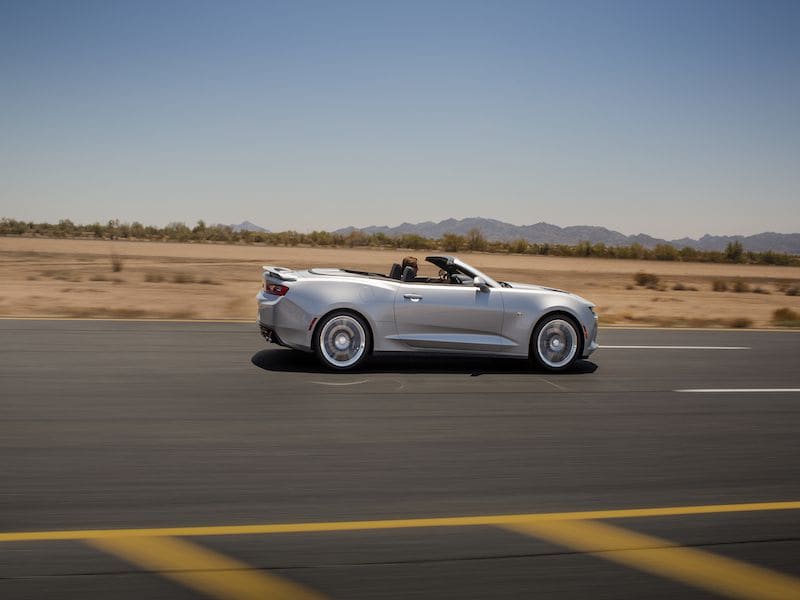
Comfort and Cargo
There are a couple of seats in the back, but the most generous way to describe the Camaro’s accommodations are “two plus two.” It’s no country for young adults back there, let alone old men. Best to leave it for bags, jackets and toddlers who don’t get claustrophobic. Up front, it’s a different story. Although after a few hours, some people might be wishing the seats were a touch more cushioned and supportive. In between times, there seems to be sufficient side bolstering to hold occupants through quick corners. Which is something the driver will want to do a lot of, because the chassis is precise and positive without becoming bone-jarring, even if the ride quality is generally on the firm side and road drone chimes in at higher speeds. At least the convertible’s fabric roof does a decent job of sealing out noise up until then. Trunk space in the coupe (if that’s important) is quite good, easily enough for a weekend’s luggage for two, although the shape and size of the opening is not that practical. The convertible’s roof cuts down cargo volume considerably, but keep the roof up and there’s still a useful area.
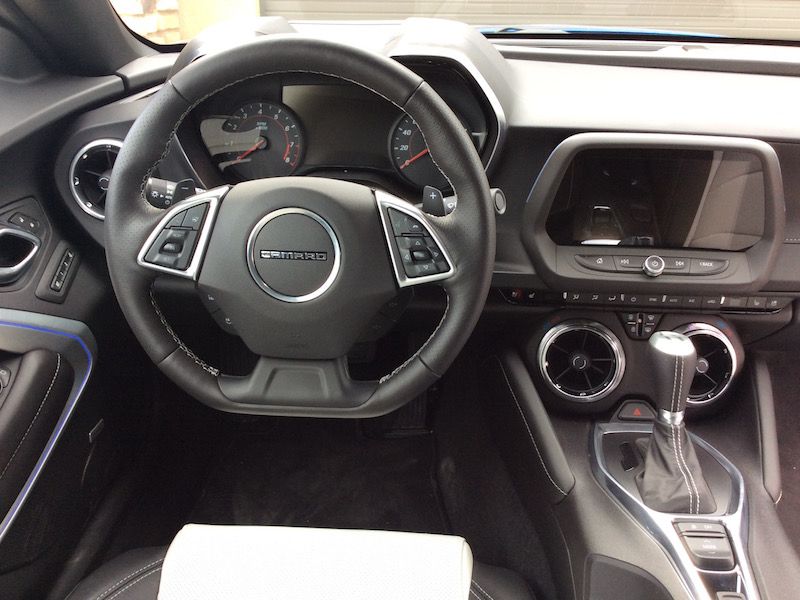
Features and Controls
The 1LT trim starts out with 18-inch alloy wheels, power-adjustable front seats, driving mode selector (snow/ice, tour, sport), leather-wrapped steering wheel (which is also flat-bottomed) and leather-wrapped shift lever, LED running lights, Bluetooth, and various other features. Then things become lusher with higher trim levels and options bundles. Dual-zone climate control and heated/ventilated front seats are just a part of the 2LT trim. For a performance machine, there are many little luxuries available, like Bose audio, driver’s seat memory settings, navigation, auto-dimming mirrors, parking sensors, and wireless phone charging. 1SS is similar to 1LT, except that there’s a sportier suspension tune to complement the V8 engine, plus 20-inch wheels, rear spoiler, beefier brakes (Brembo) and a Track setting in the drive mode selector. And 2SS is along the same lines as 2LT. The drive mode selector toggles between various presets that change responses in the steering, throttle, suspension and, in the case of the automatic transmission, gearshift points. The automatic transmission also brings steering wheel-mounted paddle shifters. The SS model can be specified with magnetic ride control: active suspension damping that can be adjusted from track-attacking stiffness to passenger-pleasing comfort. A rear window of real (heated) glass is in the convertible's power folding roof. It’s possible to bring the top up or down on the move at speeds of up to 30 mph. Or there’s always the remote operation with the key fob for a little theatrical flourish in the parking lot. A little separator in the trunk has to be in place for all this to happen. Adjusting the temperature of the air conditioning system is done by turning the metallic-finished surrounds of the center console’s vents. Which is a neat way of doing things. Another smart move is the inclusion of an electronic parking brake, which allows the cup holders in the center to be positioned so they don’t interfere with gear shifts if there’s a manual transmission. The engine start button is unimaginative, though, it’s just a dark grey square. It needs to appear more important, to have a bit of drama, even be repositioned to a more visible spot. The infotainment system is compatible with Apple CarPlay and Android Auto, both methods of superimposing smartphone functionality onto the system’s “brain.” Only one of these apps can be used at a time, though.
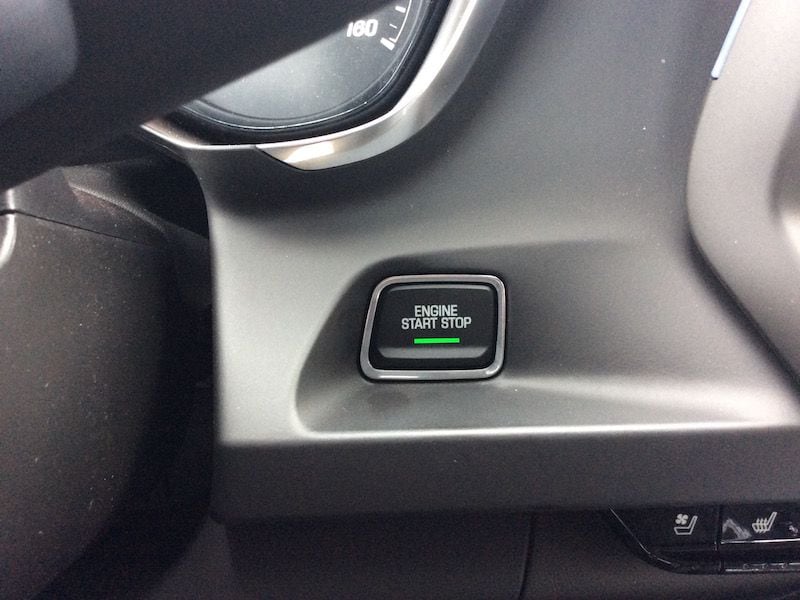
Safety
The 2016 Camaro’s standard safety equipment includes anti-lock disc brakes, front-seat knee and side airbags, full-length side curtain airbags, and traction/stability control. The OnStar telematics system is also standard, offering turn-by-turn navigation, roadside assistance, remote door unlocking, automatic crash notification, and stolen vehicle location. This sixth-generation Camaro has yet to be crash-tested by the National Highway Traffic Safety Administration (NHTSA) or the Insurance Institute for Highway Safety (IIHS). As mentioned, visibility is not a Camaro strong point. Fortunately, a rearview camera is standard throughout the range, while safety features like blind spot monitoring with rear cross-traffic alert and lane departure warning are part of an options package in the 2LT, and standard in the 2SS.
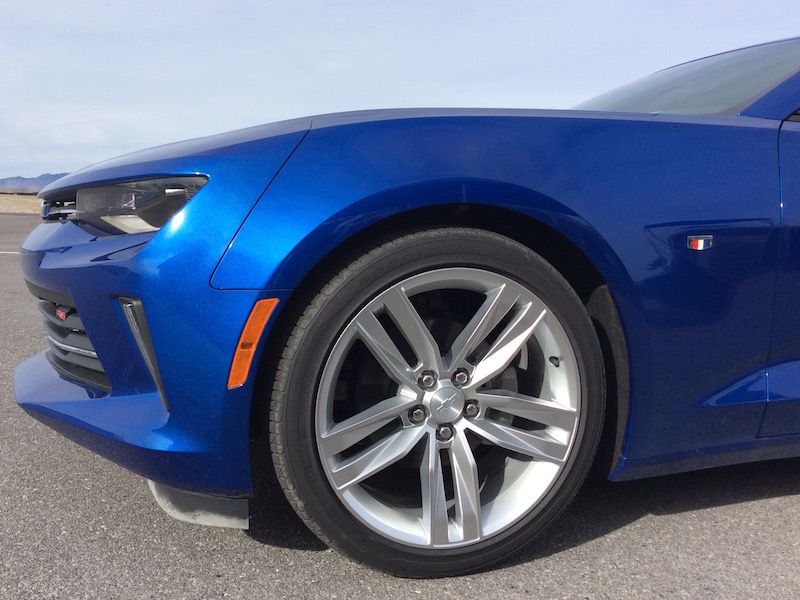
Engines and Economy
Now we get to the good stuff. Each engine has an aluminum block and head, and uses variable valve timing and direct fuel injection. A six-speed manual transmission is standard throughout the 2016 model range; an eight-speed automatic transmission. And both send power to the rear wheels only. The 2.0-liter turbo four (which is also going in a couple of the smaller Cadillac models) makes 275 hp and 295 lb-ft of torque. The Environmental Protection Agency (EPA) has estimated fuel consumption (of premium gas) with the manual transmission at 21 mpg city, 30 mpg highway and 24 mpg combined. With the automatic transmission, it’s 22/31/25 mpg. You normally see such numbers in relation to something like a thrill-a-never Toyota Camry, not a sporty machine. The 3.6-liter V6 develops 335 hp and 284 lb-ft of torque. When linked to the manual transmission, fuel use (regular octane) is estimated at 18/27/21 mpg; the automatic improves those figures to 19/28/23 mpg. The 6.2-liter V8 generates a mighty 455 hp and 455 lb-ft of torque and, with the manual transmission, returns 16/25/19 mpg. The automatic version achieves 17/28/20 mpg.

Performance
The V8 engine is gorgeously anti-social. Actually, it’s the opposite of anti-social, because it sounds so good that everyone should hear and enjoy it. Drivers would be doing a public service by revving it hard. At least during daytime hours. Not that the SS model would hang around for long. It sprints from standstill to 60 mph in a fleeting 5.1 seconds (with the automatic transmission) and acceleration from 40 mph to 70 mph is similarly swift. Choose the manual transmission and this version has an automatic rev-matching function for the downshifts. The 2.0 turbo is still fun, just not endowed with the kind of brute force normally associated with muscular cars like the Camaro. The upside is that this engine is the lightest of the three and the sixth-generation Camaro is lighter than the previous model. When linked with the manual transmission (which also weighs less than the automatic) there’s an immediacy to the car, an exciting responsiveness. Manual versions also have a limited-slip differential, so that helps with the handling too. Maximum torque kicks in at 3000 rpm, so it needs an active right foot to keep the turbo on song. Which makes the V6 either a happy medium or neither one thing nor the other, depending on one’s preferences. It sounds cool and has more of that effortless power delivery that seems so appropriate in this kind of car. It might even be the most fitting choice, but the best part is that we have the choice. The convertible Camaro feels exactly what it is, a well-reinforced convertible. This is more apparent in the driver’s seat than the passenger’s seat. If you’re the passenger, the whole car feels pretty much like a coupe when it has the roof up. The engineers responsible for chopping off the tin top and fitting an X-brace under the car did an excellent job. Chevrolet claims 10 percent more torsional rigidity compared with the previous generation’s model.
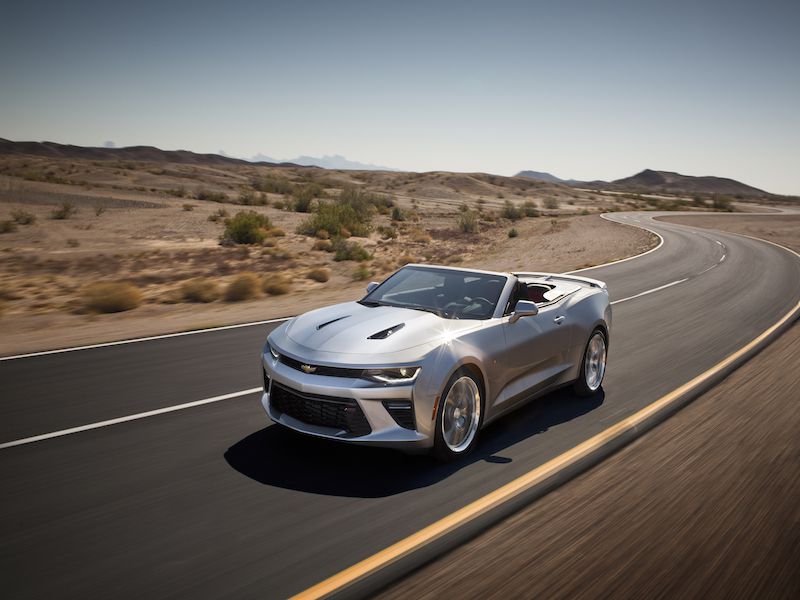
Pros and Cons
: Fuel efficiency is not usually the thing that makes or breaks a deal for Camaro buyers, but the 2.0 version is the most fuel-efficient Camaro ever — which has to count for something. Most enthusiasts don’t tend to favor convertibles, they prefer the rigidity that only a fixed roof can bring and don’t want the extra weight of lower-body reinforcement, but this one is still worth driving and its far from frivolous. : Visibility — yes, it was mentioned before and then kind of dismissed because it comes with the pony car territory, but if there is a downside beyond the acceptable limitations of a snug, rear-drive coupe/convertible, then this is it.
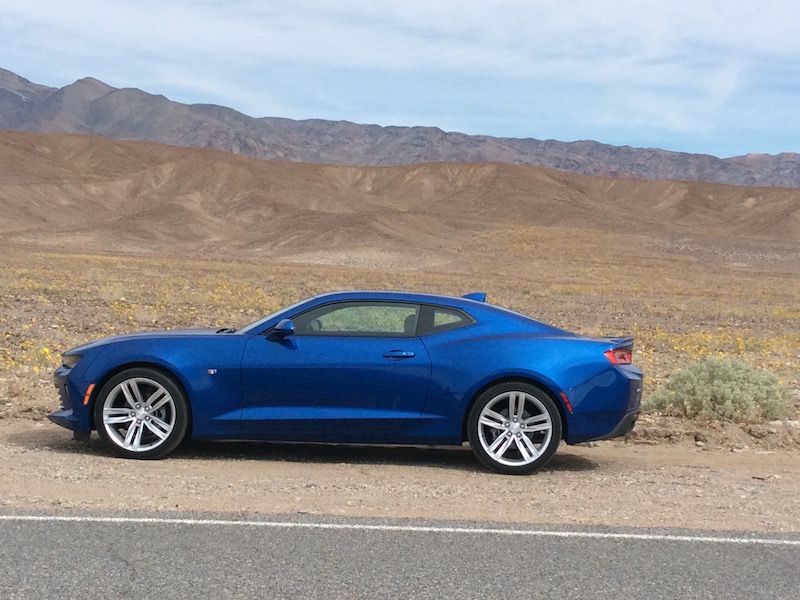
Final Thoughts
Ford is supposedly bringing forward the next generation of Mustang by two years. That could easily be because the 2016 Chevrolet Camaro is so extraordinarily good. It’s certainly providing some strong competition not only in the convertible realm, but also in the engine bay and the suspension departments. At the time of writing this review, Chevrolet just announced the track-ready 2017 Camaro ZL1 coupe with a 640-hp supercharged V8 (from the Corvette Z06), 10-speed automatic transmission and race-tuned suspension. Putting it up against the Ford Mustang Shelby GT350 should be deeply interesting. For the rest of us who won’t be turning hot laps every dry weekend, we have three engines to choose from and there isn’t a dud among them. After that, it’s just a question of selecting a trim level, but do seriously consider those active safety features.
